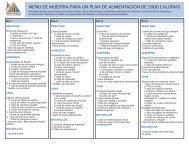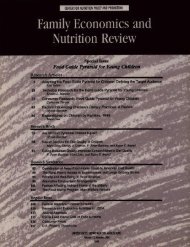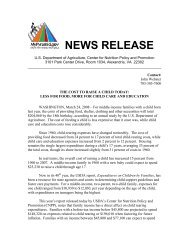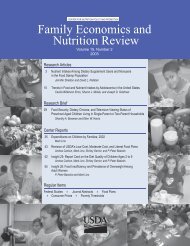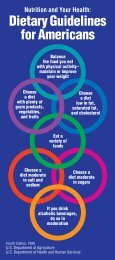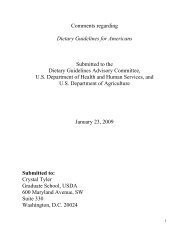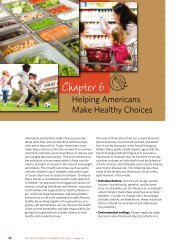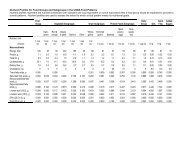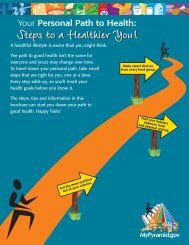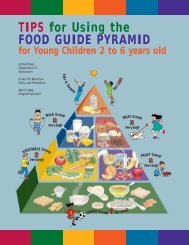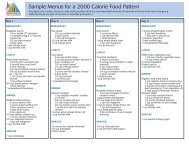Elderly Nutrition - Center for Nutrition Policy and Promotion - US ...
Elderly Nutrition - Center for Nutrition Policy and Promotion - US ...
Elderly Nutrition - Center for Nutrition Policy and Promotion - US ...
Create successful ePaper yourself
Turn your PDF publications into a flip-book with our unique Google optimized e-Paper software.
women often continue working past<br />
age 65 (Herz, 1988). This trend is<br />
expected to continue as members of<br />
the baby-boom generation reach their<br />
elder years (Purcell, 2000).<br />
Rural versus nonrural (urban <strong>and</strong><br />
suburban) residence also was included<br />
in the empirical model, as were<br />
multivitamin/multimineral intake,<br />
age, race, <strong>and</strong> region of residence.<br />
Results<br />
Results indicated that the rural <strong>and</strong><br />
nonrural samples were similar (table 1).<br />
Respondents typically had less than a<br />
high school education (40 percent <strong>for</strong><br />
the total sample, 45 percent <strong>for</strong> rural<br />
residents, <strong>and</strong> 37 percent <strong>for</strong> nonrural<br />
residents). Average age of the sample<br />
was close to 74 years. The largest<br />
proportion of rural residents lived in<br />
the South (43 percent), while about an<br />
equal proportion of nonrural residents<br />
lived in the Northeast, South, or<br />
Midwest (28, 28, <strong>and</strong> 27 percent,<br />
respectively). Close to 90 percent of<br />
both rural <strong>and</strong> nonrural respondents<br />
were White, did not receive food<br />
stamps, <strong>and</strong> were not employed.<br />
Regarding attitudes <strong>and</strong> behavior<br />
related to food procurement <strong>and</strong><br />
preparation, close to three-fourths of<br />
both rural <strong>and</strong> nonrural respondents<br />
indicated that nutrition, taste, <strong>and</strong> food<br />
not spoiling were very important. A<br />
little over half of each group did not<br />
consider easy preparation to be very<br />
important, most did not use nutrition<br />
labels, <strong>and</strong> about 90 percent of each<br />
group had primary responsibility <strong>for</strong><br />
preparing meals. Slightly less than<br />
half (44 to 47 percent) of each group<br />
took a daily multivitamin/multimineral<br />
supplement. Study participants seemed<br />
to have adequate but relatively low<br />
economic resources: income was,<br />
on average, near 180 percent of the<br />
poverty level. Each group answered<br />
Table 1. Descriptive statistics <strong>for</strong> single elderly women<br />
Variables Total 1 Rural 1 Nonrural 1<br />
Mean<br />
Continuous<br />
<strong>Nutrition</strong> knowledge test 8.0 8.2 7.9<br />
(number correct of a possible 13)<br />
Income (% of poverty level) 184.9 182.4 185.9<br />
Age (years) 73.6 74.7 73.2<br />
Percent<br />
Categorical<br />
Education<br />
Less than high school 40 45 37<br />
High school 30 26 32<br />
Some college 17 14 18<br />
College 13 15 13<br />
Race<br />
White 85 94.5 81<br />
Black 13 5 16<br />
Asian <strong>and</strong> Pacific Isl<strong>and</strong>er 0.5 0 1<br />
Other 2 1.5 0.5 3<br />
Region<br />
Northeast 23 11 28<br />
South 33 43 28<br />
Midwest 30 38 27<br />
West 14 8 17<br />
Employment<br />
Full-time 2 1 2<br />
Part-time 8 11 7<br />
Not working 90 88 91<br />
Receipt of food stamps<br />
Yes 8 5 9<br />
No 92 95 91<br />
Importance of nutrition<br />
Very important 74 75 73<br />
All other responses 3 26 25 27<br />
Importance of taste<br />
Very important 86 87 85<br />
All other responses 3 14 13 15<br />
Importance of food not spoiling<br />
Very important 73 78 70<br />
All other responses 3 27 22 30<br />
Importance of easy preparation of food<br />
Very important 42 39 43<br />
All other responses 3 58 61 57<br />
Use nutrition labels<br />
Use often (always) 34 35 38<br />
All other responses 4 66 65 62<br />
Main responsibility <strong>for</strong> meals<br />
Yes 90 91 90<br />
No 10 9 10<br />
Take vitamins daily<br />
Yes 46 44 47<br />
No 54 56 53<br />
1 Sample size: total = 732, rural = 218, <strong>and</strong> nonrural = 514.<br />
2 Native American, Alaskan Native, <strong>and</strong> other races.<br />
3 Somewhat important, not too important, not at all important, don’t know.<br />
4 Sometimes, rarely, never.<br />
2003 Vol. 15 No. 1 77



